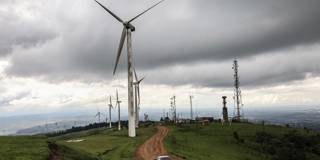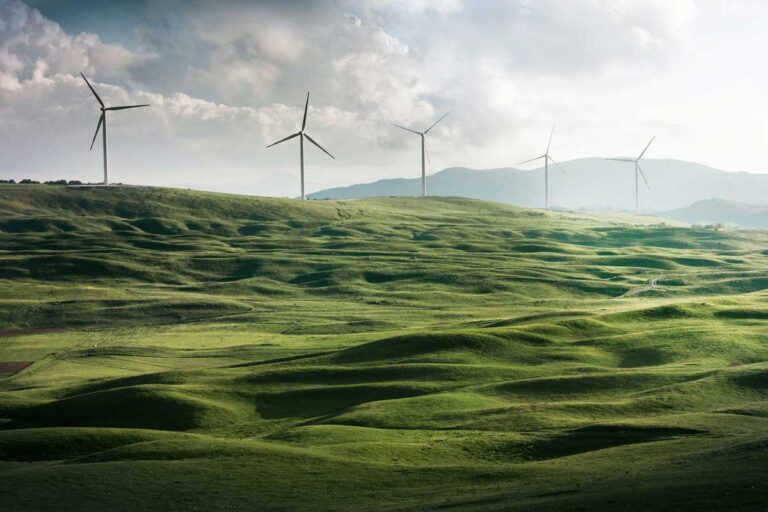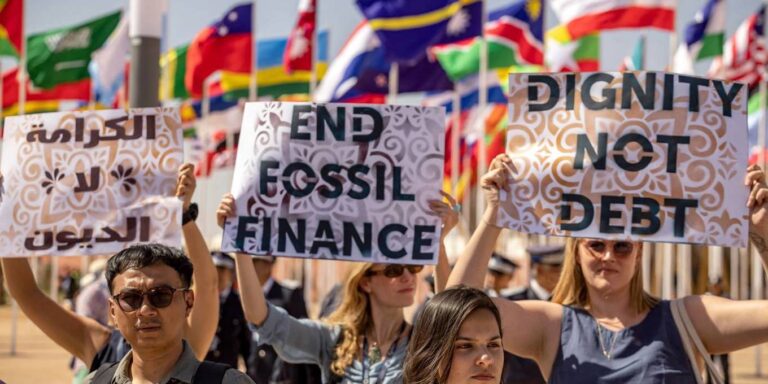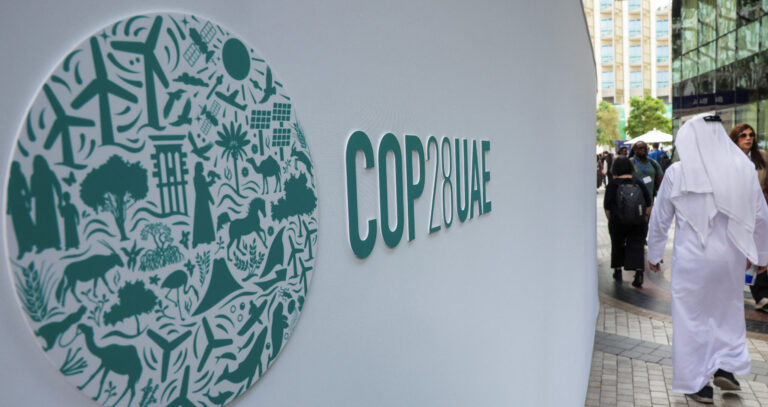Only public-private co-operation can accelerate decarbonisation

As countries around the world experienced record temperatures last year, UN Secretary-General Antonio Guterres declared: “We must turn a year of burning heat into a year of burning ambition.” But to move away from fossil fuels and unlock the green transition’s economic benefits, such as job creation and universal access to clean energy, industry leaders and policymakers must work together to translate the commitments made at the UN Climate Change Conference in Dubai (COP28) into actual renewable gigawatts.
COP28 marked a historic turning point in the battle against climate change. Rallying around the UAE Consensus, world leaders pledged to move away from fossil fuels, agreeing to triple renewable power capacity to at least 11,000 gigawatts and double energy efficiency by 2030.
But ambition alone is not enough to achieve these targets and limit global warming to 1.5C. Governments must invest in mature, cost-competitive renewable technologies that can be rapidly deployed at scale. When integrated with long-duration energy storage, green hydrogen, and system optimisation, these technologies represent the most reliable and flexible way to accelerate the energy transition.
Renewables will undoubtedly shape the global energy landscape in the coming years. Both solar and wind power are expected to grow significantly, with hydropower serving as the backbone of grid flexibility. Consequently, renewables are poised to become the twenty-first century’s dominant source of global electricity.
But as a joint report released by the International Renewable Energy Agency (IRENA) and the Global Renewables Alliance (GRA) ahead of COP28 noted, tripling renewable capacity will require cooperation between the private and public sectors. Partnerships should focus on initiatives that deliver immediate results, such as mobilising low-cost financing, accelerating permitting processes, clearing grid connection backlogs, reforming government auction mechanisms for renewable-energy projects, and diversifying global supply chains. A strong commitment to inclusivity and the active participation of developing economies must be at the heart of these efforts. IRENA and GRA are demonstrating this commitment by collaborating on the annual reports commissioned by the COP28 Presidency to monitor progress toward the global tripling target and facilitate the energy transition.
We must, however, move faster, especially if we aim to ensure that progress is equitably distributed around the world. While renewable power capacity rose by 473 gigawatts in 2023, the economic benefits of the energy transition did not reach every country. Remarkably, 83% of these increases were concentrated in China, the European Union, and the US, leaving many countries in the Global South behind.
In fact, the shift to renewables is alarmingly slow in many parts of the world. Opportunities to address development and access challenges in Sub-Saharan Africa, where more than 500mn people still lack access to electricity, are being squandered. This sluggish transition can be attributed largely to the lack of affordable financing, adequate planning, and the policy and market frameworks needed to support the adoption of renewable energy. Tellingly, public fossil-fuel subsidies reached $1.3tn in 2022 – roughly the annual investment needed to triple renewable capacity by 2030.
A critical first step toward fostering greater public-private co-operation in pursuit of COP28’s ambitious targets is to reform the global financial architecture. Africa, for example, accounts for 17% of the world’s population but has received less than 2% of global investments in renewable energy over the past two decades, underscoring the need to reduce capital costs and attract private investors. Developing industrial clusters and initiating grant programs could also help foster environments conducive to innovation and private-public partnerships.
Recent commitments by world leaders offer glimmers of hope. African leaders at the September 2023 Africa Climate Summit in Nairobi, for example, pledged to increase the continent’s renewable capacity to at least 300 gigawatts by 2030. This effort aims to reduce energy poverty and boost the global supply of cost-effective clean energy suitable for industrial use.
Kenyan President William Ruto, a key advocate of the Nairobi agreement, established the Accelerated Partnership for Renewables in Africa, an African-led international alliance of governments and stakeholders that aims to accelerate renewable-energy deployment, increase access, promote green industrialisation, and strengthen economic and societal resilience.
Governments and business leaders should harness the current political momentum to foster co-operation between policymakers and private investors. As governments develop appropriate policy and market frameworks to facilitate the transition to renewables, the private sector – historically responsible for 86% of global investments in renewable energy – is poised to lead the charge. Together, we can achieve a clean, secure, and just energy future. But to realise this vision, we must act fast. – Project Syndicate
- Francesco La Camera is Director-General of the International Renewable Energy Agency. Bruce Douglas is CEO of the Global Renewables Alliance.









BOGOTÁ/NAIROBI – Last month, the International Energy Agency’s ministerial gathering took place in Paris, while the African Union, which recently joined the G20, held its annual summit in Addis Ababa. Both fora recognized the urgent need to fulfill the commitments made at last December’s United Nations Climate Change Conference (COP28) in Dubai, not least to triple installed renewable-energy capacity by 2030. But the challenges ahead are substantial.
COP28 identified many actions that are crucial to achieving net-zero emissions by 2050. Beyond the sharp increase in renewable-energy capacity, these include doubling the rate of energy-efficiency improvements by 2030, phasing down the “unabated” use of fossil fuels, and providing financial support to developing countries as they work to expand energy access and advance economic development.
Africa and Latin America have a central role to play in fulfilling the world’s net-zero ambitions. Both regions boast abundant renewable-energy potential, thanks to vast solar, wind, hydro, and geothermal resources. By leveraging these, Africa and Latin America can make rapid progress in reducing their carbon emissions, enhancing energy access, and stimulating sustainable economic growth.
Our countries, Colombia and Kenya, are already making significant strides toward a cleaner energy mix. Though Colombia has massive oil and gas reserves, hydropower generation accounts for nearly 70% of its electricity production. And the government is committed to increasing the share of renewables in the energy mix further by 2030. By harnessing wind, solar, biomass, and geothermal, Colombia can diversify its renewable-energy portfolio and further reduce its reliance on fossil fuels.
Colombia is also taking direct action to accelerate the phaseout of fossil fuels. The government recently announced a ban on the issuance of new licenses for oil and gas exploration, and has signaled its intention to address the negative effects of fossil-fuel extraction. These measures will not only curb carbon emissions, but also help protect the country’s vulnerable ecosystems and rich biodiversity.
As for Kenya, it is emerging as a renewable-energy success story in Africa. Using its vast geothermal, wind, solar, and hydroelectric resources, Kenya has raised the share of renewables in its electricity generation to a whopping 94%. Its geothermal sector has achieved remarkable growth, making it Africa’s leading producer of geothermal power. And now, Kenya is helping its neighbors, Ethiopia and Djibouti, to harness their own geothermal resources as well.
Underpinning Kenya’s progress are government efforts to implement supportive policies and create an enabling environment for private investment. The Kenyan government’s forward-thinking approach has not only resulted in expanded energy access for its people; it has also created jobs and local industries, thereby advancing economic development and opening up opportunities to collaborate with others. Kenya is a founding member of Accelerated Partnerships for Renewables in Africa, an initiative that aims to bolster the energy transition in African countries, with support from Denmark, Germany, and the United Arab Emirates.
Colombia and Kenya’s achievements should be highlighted and celebrated to motivate and guide other countries in their own clean-energy transitions. Those with fossil-fuel resources, for example, must follow Colombia’s example in limiting oil and gas exploration.
But Colombia and Kenya are not only passive models for others to follow; they are also active global leaders. If their clean-energy transitions didn’t already make their commitments apparent, their recent decision to join the Beyond Oil & Gas Alliance – an international coalition of governments and partners working to facilitate the fossil-fuel phaseout – should make them so.
Still, financing is key if the world is to realize its clean-energy ambitions. Low investment in Africa is a major challenge. A recent BloombergNEF report shows that in 2021, just 0.6% ($2.6 billion) of the $434 billion invested in renewable-energy projects went to African countries. A sharp increase in funding flows from rich countries to clean-energy sectors in both Africa and Latin America is urgently needed.
Beyond direct financial support from rich countries, the global financial system – including the International Monetary Fund and multilateral development banks – must urgently be reformed, so that it is fairer and more efficient. Only then can this system deliver enough financing to meet the growing needs of developing economies. Coordinated action to ease the debt burdens on developing economies is also vital.
At COP28, the Global South demonstrated solidarity and a commitment to cooperation. By sharing knowledge and best practices, developing economies can drastically accelerate the clean-energy transition. But, if the world is to succeed at combating climate change and safeguarding our collective future, bold action to ensure adequate financing is essential.